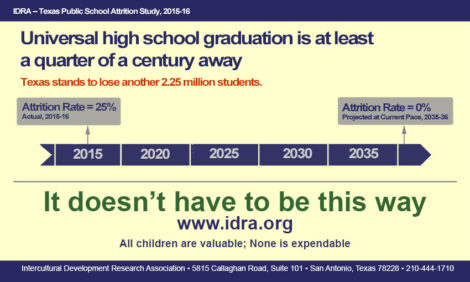IDRA Forecast Analysis: At Our Current Pace in Texas, Universal High School Education is Two Decades Away


IDRA’s forecast shows that we should expect attrition rates in the range 22 percent to 25 percent for the next few years. We should also expect to lose millions of students to attrition before we reach a zero attrition rate unless this issue is considered seriously by policymakers and systemic changes implemented to ameliorate the problem.
“So the question is, are we serious about getting results for every child?” said Dr. María “Cuca” Robledo Montecel, IDRA president and CEO. “We need to be honest about the fact that, right now, we plan for 25 percent attrition and we budget for a two-tiered system. We assume that fewer students will graduate than started in the ninth grade and even fewer children will graduate than started in kindergarten. This assumption is built into teacher hiring practices, into ways in which schools deal with parents and communities, into whether and how schools connect with kids, and into curriculum decisions about which courses will be offered and to whom. Student attrition is built in to facilities planning and funding decisions.”
After 17 years of slow decline, the high school rate in Texas reversed to 25 percent, after reaching 24 percent last year, the lowest level ever calculated by the IDRA annual analysis. The last time an upward reversal happened (1991-92), the new upward trend continued for five years. Will this happen again? IDRA conducted a forecast analysis to find out.
The most current forecast indicates that 2036 will be the year when attrition will reach zero. The contemporary model indicates that the attrition rate will reach single digits in the late 2020s and will progressively decrease to minimal values from there.
IDRA’s statement of principles for policymakers and school leaders, “Uncompromising Expectations for Graduating All Students,” begins by asserting: “All students enrolled in U.S. schools should be expected, and must be supported, to graduate from high school with a regular high school diploma in four years.”
“Texas has the capacity, ingenuity and the resourcefulness to get results,” added Dr. Robledo Montecel. “Fortunately, we know what to do and we can do what it takes. We can make sure students have access to highly-qualified committed teachers, using high-quality curricula. And we can make sure that their parents and communities are engaged in their schools and that the state provides fair funding to prepare students for 21st century opportunities. If we want to have the better results, we have to truly invest and we have to be strategic.”
IDRA’s Quality School Action Framework™ guides communities and schools in identifying weak areas and strengthening public schools’ capacities to graduate and prepare all students for success. IDRA’s book, Courage to Connect: A Quality Schools Action Framework™ shows how communities and schools can work together to be successful with all of their students.
IDRA’s attrition study and supplemental reports released this month are available online.
# # #
IDRA Resources Online
Article: Attrition Rate Trend Reversed, Pushing Zero Attrition Rate Farther into the Future
See infographic: Texas public schools are losing one out of four students
2016 Study – Texas Public School Attrition Study, 2014-16
Courage to Connect: A Quality Schools Action Framework
College Bound and Determined – A report profiling what happens when a school district raises expectations for students instead of lowering them
Overview of the Coca-Cola Valued Youth Program, which keeps 98 percent of students in school
Ideas and Strategies for Action
Set of principles for policymakers and school leaders


